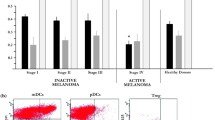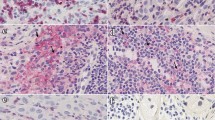Abstract
As the most potent antigen presenting cells, dendritic cells (DCs) play key roles in the immune response against tumors. Their density in the tumor tissue has been associated with prognosis in patients with various cancers. However, few studies have been aimed at the presence and maturation state of DCs in cutaneous melanoma, with regard to their potential clinical correlates. In this study, the density of DCs expressing CD1a and the maturation marker DC-LAMP was determined by immunohistochemistry in primary tumor samples from 82 patients with cutaneous malignant melanoma. Intratumoral and peritumoral cell densities were analyzed in relation to tumor thickness and the subsequent development of metastases, as well as to patients’ survival. CD1a+ DCs were found both infiltrating melanoma cell nests and in the surrounding stroma, while DC-LAMP+ mature DCs were generally confined to the peritumoral areas, associated with lymphocytic infiltrates. DC density values significantly correlated with the number of activated (CD25+ or OX40+) T lymphocytes (p < 0.001). The degree of infiltration by CD1a+ and DC-LAMP+ DCs showed strong inverse correlation with the thickness of melanomas (p < 0.001). High peritumoral density of mature DCs was associated with significantly longer survival (p = 0.0195), while density of CD1a+ cells had a prognostic impact of borderline significance (p = 0.0610). Moreover, combination of high peritumoral CD1a+ or DC-LAMP+ cell density with high number of CD25+ or OX40+ lymphocytes identified patient subgroups with more favorable survival compared to other subgroups. A multivariate survival analysis involving DC and activated T-cell densities alone and in combinations, as well as traditional prognostic factors, identified high DC-LAMP+ cell/high OX40+ cell density and Breslow index as independent predictors of good prognosis. These results suggest that the presence of CD1a+ DCs primarily depends on the thickness of melanomas, without direct relationship with the patients’ survival. On the other hand, the density of mature DCs, especially in association with that of activated T cells, proved of prognostic importance, suggesting that these parameters could be considered as signs of a functional immune response associated with better outcome of the disease.



Similar content being viewed by others
References
Albert ML, Jegathesan M, Darnell RB (2001) Dendritic cell maturation is required for the cross-tolerization of CD8+ T cells. Nat Immunol 2:1010–1017
Almand B, Resser JR, Lindman B, Nadaf S, Clark JI, Kwon ED, Carbone DP, Gabrilovich DI (2000) Clinical significance of defective dendritic cell differentiation in cancer. Clin Cancer Res 6:1755–1766
Ambe K, Mori M, Enjoji M (1989) S-100 protein-positive dendritic cells in colorectal adenocarcinomas. Distribution and relation to the clinical prognosis. Cancer 63:496–503
Balch CM, Buzaid AC, Soong S-J, Atkins MB, Cascinelli N, Coit DG, Fleming ID, Gershenwald JE, Houghton A Jr, Kirkwood JM, McMasters KM, Mihm MF, Morton DL, Reintgen DS, Ross MI, Sober A, Thompson JA, Thompson JF (2001) Final version of the American Joint Committee on Cancer staging system for cutaneous melanoma. J Clin Oncol 19:3635–3648
Banchereau J, Steinman RM (1998) Dendritic cells and the control of immunity. Nature 392:245–252
Bell D, Chomarat P, Broyles D, Netto G, Harb GM, Lebecque S, Valladeau J, Davoust J, Palucka KA, Banchereau J (1999) In breast carcinoma tissue, immature dendritic cells reside within the tumor, whereas mature dendritic cells are located in peritumoral areas. J Exp Med 190:1417–1425
Bröcker EB, Zwadlo G, Holzmann B, Macher E, Sorg C (1988) Inflammatory cell infiltrates in human melanoma at different stages of tumor progression. Int J Cancer 41:562–567
Cella M, Sallusto F, Lanzavecchia A (1997) Origin, maturation and antigen presenting function of dendritic cells. Curr Opin Immunol 9:10–16
Chaux P, Moutet M, Faivre J, Martin F, Martin M (1996) Inflammatory cells infiltrating human colorectal carcinomas express HLA class II but not B7-1 and B7-2 costimulatory molecules of the T-cell activation. Lab Invest 74:975–983
Conrad CT, Ernst NR, Dummer W, Bröcker EB, Becker JC (1999) Differential expression of transforming growth factor beta 1 and interleukin 10 in progressing and regressing areas of primary melanoma. J Exp Clin Cancer Res 18:225–232
de Saint-Vis B, Vincent J, Vandenabeele S, Vanbervliet B, Pin JJ, Ait-Yahia S, Patel S, Mattei MG, Banchereau J, Zurawski S, Davoust J, Caux C, Lebecque S (1998) A novel lysosome-associated membrane glycoprotein, DC-LAMP, induced upon DC maturation, is transiently expressed in MHC class II compartment. Immunity 9:325–336
Enk AH, Jonuleit H, Saloga J, Knop J (1997) Dendritic cells as mediators of tumor-induced tolerance in metastatic melanoma. Int J Cancer 73:309–316
Esche C, Lokshin A, Shurin GV, Gastman BR, Rabinowich H, Watkins SC, Lotze MT, Shurin MR (1999) Tumor’s other immune targets: dendritic cells. J Leukoc Biol 66:336–344
Facchetti F, Vermi W, Mason D, Colonna M (2003) The plasmacytoid monocyte/interferon producing cells. Virchows Arch 443:703–717
Fullen DR, Headington JT (1998) Factor XIIIa-positive dermal dendritic cells and HLA-DR expression in radial versus vertical growth-phase melanomas. J Cutan Pathol 25:553–558
Gabrilovich DI, Chen HL, Girgis KR, Cunningham T, Meny GM, Nadaf S, Kavanaugh D, Carbone DP (1996) Production of vascular endothelial growth factor by human tumors inhibits the functional maturation of dendritic cells. Nat Med 2:1096–1103
Gabrilovich DI, Ciernik F, Carbone DP (1996) Dendritic cells in antitumor immune responses I. Defective antigen presentation in tumor-bearing hosts. Cell Immunol 170:101–110
Gabrilovich DI, Corak J, Ciernik IF, Kavanaugh D, Carbone DP (1997) Decreased antigen presentation by dendritic cells in patients with breast cancer. Clin Cancer Res 3:483–490
Geissmann F, Revy P, Regnault A, Lepelletier Y, Dy M, Brousse N, Amigorena S, Hermine O, Durandy A (1999) TGF-β1 prevents the noncognate maturation of human dendritic Langerhans cells. J Immunol 162:4567–4575
Inoshima N, Nakanishi Y, Minami T, Izumi M, Takayama K, Yoshino I, Hara N (2002) The influence of dendritic cell infiltration and vascular endothelial growth factor expression on the prognosis of non-small cell lung cancer. Clin Cancer Res 8:3480–3486
Ishigami S, Aikou T, Natsugoe S, Hokita S, Iwashige H, Tokushige M, Sonoda S (1998) Prognostic value of HLA-DR expression and dendritic cell infiltration in gastric cancer. Oncology 55:65–69
Ishigami S, Natsugoe S, Matsumoto M, Okumura H, Sakita H, Nakashima S, Takao S, Aikou T (2003) Clinical implications of intratumoral dendritic cell infiltration in esophageal squamous cell carcinoma. Oncol Rep 10:1237–1240
Iwamoto M, Shinohara H, Miyamoto A, Okuzawa M, Mabuchi H, Nohara T, Gon G, Toyoda M, Tanigawa N (2003) Prognostic value of tumor-infiltrating dendritic cells expressing CD83 in human breast carcinomas. Int J Cancer 104:92–97
Ladányi A, Somlai B, Gilde K, Fejös Z, Gaudi I, Tímár J (2004) T-cell activation marker expression on tumor-infiltrating lymphocytes as prognostic factor in cutaneous malignant melanoma. Clin Cancer Res 10:521–530
Lenz A, Heine M, Schuler G, Romani N (1993) Human and murine dermis contain dendritic cells. J Clin Invest 92:2587–2596
Lutz M, Schuler G (2002) Immature, semi-mature and fully mature dendritic cells: which signals induce tolerance or immunity? Trends Immunol 23:445–449
Mahnke K, Schmitt E, Bonifaz L, Enk AH, Jonuleit H (2002) Immature but not inactive: the tolerogenic function of immature dendritic cells. Immunol Cell Biol 80:477–483
McLellan AD, Heiser A, Sorg RV, Fearnley DB, Hart DNJ (1998) Dermal dendritic cells associated with T lymphocytes in normal human skin display an activated phenotype. J Invest Dermatol 111:841–849
Movassagh M, Spatz A, Davoust J, Lebecque S, Romero P, Pittet M, Rimoldi D, Liénard D, Gugerli O, Ferradini L, Robert C, Avril M-F, Zitvogel L, Angevin E (2004) Selective accumulation of mature DC-Lamp+ dendritic cells in tumor sites is associated with efficient T-cell-mediated antitumor response and control of metastatic dissemination in melanoma. Cancer Res 64:2192–2198
Péguet-Navarro J, Sportouch M, Popa I, Berthier O, Schmitt D, Portoukalian J (2003) Gangliosides from human melanoma tumors impair dendritic cell differentiation from monocytes and induce their apoptosis. J Immunol 170:3488–3494
Reichert TE, Scheuer C, Day R, Wagner W, Whiteside TL (2001) The number of intratumoral dendritic cells and ζ-chain expression in T cells as prognostic and survival biomarkers in patients with oral carcinoma. Cancer 91:2136–2147
Scarpino S, Stoppacciaro A, Ballerini F, Marchesi M, Prat M, Stella C, Sozzani S, Allavena P, Mantovani A, Ruco LP (2000) Papillary carcinoma of the thyroid: Hepatocyte growth factor (HGF) stimulates tumor cells to release chemokines active in recruiting dendritic cells. Am J Pathol 156:831–837
Shortman K, Liu Y-J (2002) Mouse and human dendritic cell subtypes. Nat Rev Immunol 21:151–161
Siegal FP, Kadowaki N, Shodell M, Fitzgerald-Bocarsly PA, Shah K, Ho S, Antonenko S, Liu Y-J (1999) The nature of the principal type 1 interferon-producing cells in human blood. Science 284:1835–1837
Steinbrink K, Jonuleit H, Müller G, Schuler G, Knop J, Enk AH (1999) Interleukin-10-treated human dendritic cells induce a melanoma-antigen-specific anergy in CD8+ T cells resulting in a failure to lyse tumor cells. Blood 93:1634–1642
Steinman RM, Hawiger D, Nussenzweig MC (2003) Tolerogenic dendritic cells. Annu Rev Immunol 21:685–711
Stene MA, Babajanians M, Bhuta S, Cochran AJ (1988) Quantitative alterations in cutaneous Langerhans cells during the evolution of malignant melanoma of the skin. J Invest Dermatol 91:125–128
Suzuki A, Masuda A, Nagata H, Kameoka S, Kikawada Y, Yamakawa M, Kasajima T (2002) Mature dendritic cells make clusters with T cells in the invasive margin of colorectal carcinoma. J Pathol 196:37–43
Tazi A, Bouchonnet F, Grandsaigne M, Boumsell L, Hance AJ, Soler P (1993) Evidence that granulocyte macrophage-colony-stimulating factor regulates the distribution and differentiated state of dendritic cells/Langerhans cells in human lung and lung cancers. J Clin Invest 91:566–576
Toriyama K, Wen D-R, Paul E, Cochran AJ (1993) Variations in the distribution, frequency, and phenotype of Langerhans cells during the evolution of malignant melanoma of the skin. J Invest Dermatol 100:269S–273S
Troy AJ, Summers KL, Davidson PJT, Atkinson CH, Hart DNJ (1998) Minimal recruitment and activation of dendritic cells within renal cell carcinoma. Clin Cancer Res 4:585–593
Udey MC (2004) Skin dendritic cells in immunity and autoimmunity. J Invest Dermatol Symp Proc 9:15–17
Vandenabeele S, Wu L (1999) Dendritic cell origins: puzzles and paradoxes. Immunol Cell Biol 77:411–419
Vermi W, Bonecchi R, Facchetti F, Bianchi D, Sozzani S, Festa S, Berenzi A, Cella M, Colonna M (2003) Recruitment of immature plasmacytoid dendritic cells (plasmacytoid monocytes) and myeloid dendritic cells in primary cutaneous melanomas. J Pathol 200:255–268
Vuylsteke RJCLM, Molenkamp BG, Gietema HA, van Leeuwen PAM, Wijnands PGJTB, Vos W, van Diest PJ, Scheper RJ, Meijer S, de Gruijl TD (2004) Local administration of granulocyte/macrophage colony-stimulating factor increases the number and activation state of dendritic cells in the sentinel lymph node of early-stage melanoma. Cancer Res 64:8456–8460
Zhou LJ, Tedder TF (1995) Human blood dendritic cells selectively express CD83, a member of the immunoglobulin superfamily. J Immunol 154:3821–3835
Acknowledgments
We thank Katalin Derecskei, Violetta Piurkó and Miklós Kónya (National Institute of Oncology) for their excellent technical assistance, and to Eric Angevin (Institut Gustave-Roussy, Villejuif, France) for helpful suggestions. The study was supported by Hungarian Ministry of Health grant ETT 308/2003, grants GVOP-3.11.-2004-05-0090.3.0 and NKFP1a-0024-05.
Author information
Authors and Affiliations
Corresponding author
Rights and permissions
About this article
Cite this article
Ladányi, A., Kiss, J., Somlai, B. et al. Density of DC-LAMP+ mature dendritic cells in combination with activated T lymphocytes infiltrating primary cutaneous melanoma is a strong independent prognostic factor. Cancer Immunol Immunother 56, 1459–1469 (2007). https://doi.org/10.1007/s00262-007-0286-3
Received:
Accepted:
Published:
Issue Date:
DOI: https://doi.org/10.1007/s00262-007-0286-3




